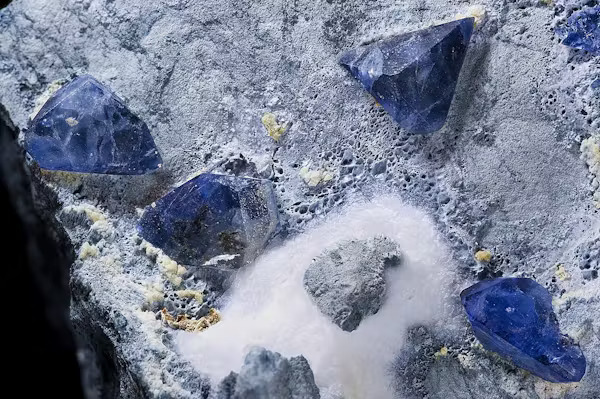
Benitoite is a rare blue gemstone first found in San Benito County, California. Known for its stunning color and scarcity, benitoite crystals are highly sought after by collectors. This article will cover its definition, geological formation, physical properties, and tips for evaluating its quality.
- Key Takeaways
- What is Benitoite?
- Origin and Geological Formation
- Physical and Chemical Properties
- Evaluating Benitoite Quality
- Metaphysical and Healing Properties
- Uses and Benefits of Benitoite
- Caring for Benitoite Stones
- Benitoite in Collections and Displays
- Famous Benitoite Specimens
- Buying and Selling Benitoite
- Summary
1 KEY TAKEAWAYS
-
Benitoite is a rare and valuable blue gemstone discovered in San Benito County, California, with significant appeal among collectors due to its unique formation conditions and scarcity.
-
The formation of benitoite requires specific geological conditions—particularly, low temperatures, high pressures, and a barium-rich, silica-deficient environment—which contribute to its distinctive blue hue and rarity.
-
Quality evaluation of benitoite is based on factors like color, clarity, cut, and size, with top-quality stones exhibiting deep blue color, minimal inclusions, and well-executed cuts being highly prized in the market.
2 WHAT IS BENITOITE?
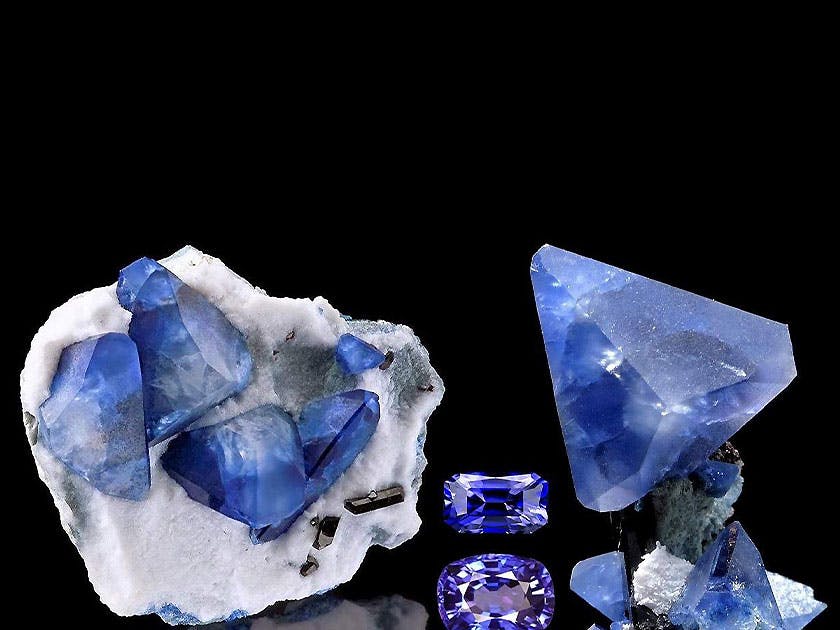
Rare gemstone benitoite by Geology
Benitoite is a rare, striking blue gemstone that was first discovered in 1907 by James Marshall Couch in San Benito County, California. This gem, named after its place of discovery, is highly valued by collectors due to its scarcity and unique formation process. In fact, San Benito County remains the only location in the world where gem-quality benitoite crystals can be found. The rarity of this gemstone is further heightened by the specific geological conditions required for its formation, making it a collector’s treasure.
The intense blue color and brilliance of benitoite make it a valued rare gemstone among enthusiasts. The pure blue stones are particularly scarce, adding to their allure and value. With its unique hue and limited availability, benitoite has become a symbol of rarity and beauty in the gem world. Collectors and gem aficionados alike seek out this gemstone, not only for its aesthetic appeal but also for its fascinating geological story.
3 ORIGIN AND GEOLOGICAL FORMATION
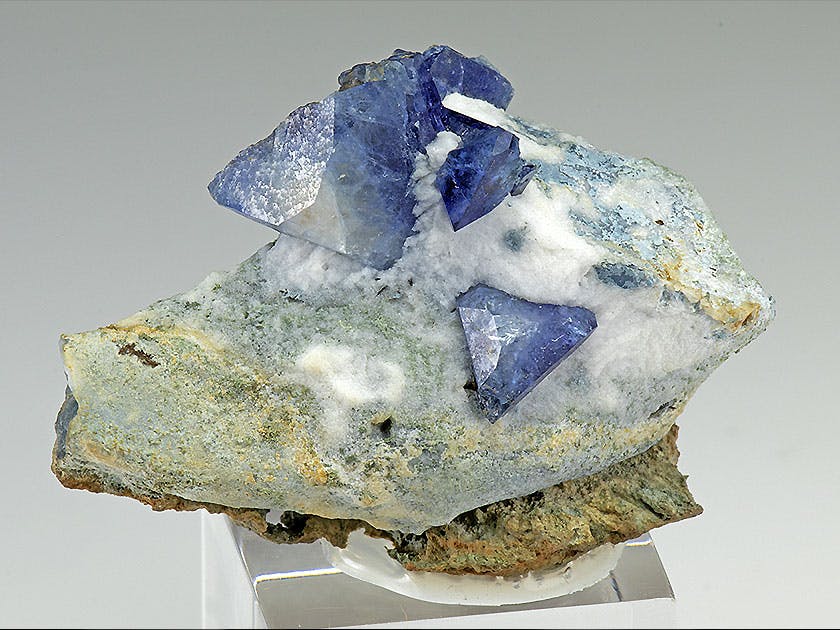
Natural benitoite mineral by Weinrich Minerals
Benitoite’s journey begins in the rugged landscapes of San Benito County, California, specifically in the Diablo Range. This area is home to the California State Gem Mine (formerly known as the Dallas Gem Mine), which served as the initial and primary source of benitoite, a California gem mineral. The formation of benitoite is a testament to nature’s ability to create beauty under unique and specific conditions. It forms from hydrothermal fluids at low temperatures and high pressures, typically at the juncture where oceanic and continental plates meet.
The geochemical environment conducive to benitoite’s formation is one rich in barium but lacking silica. This environment is part of the Joaquin Miller Formation, a metamorphic rock unit that consists of serpentine, glaucophane schist, and other minerals. The high-pressure, low-temperature conditions during the hydrothermal alteration of this formation are believed to be crucial in benitoite’s creation. The role of barium, derived from the breakdown of barium-rich minerals, and titanium, incorporated into the crystal lattice, is significant in giving benitoite its characteristic blue color. This rare and unique geological process makes benitoite not only a gem of beauty but also of scientific interest.
4 PHYSICAL AND CHEMICAL PROPERTIES
Classified as a barium titanium silicate, benitoite has a chemical composition of BaTi(Si3O9). This composition, combined with trace amounts of titanium, is responsible for its striking blue color. On the Mohs scale of hardness, benitoite scores between 6 and 6.5, placing it in the mid-range of gemstone durability. This makes it suitable for various types of jewelry, though care must be taken to avoid scratches and other damage.
Compared to other gemstones, benitoite has the following characteristics:
-
Specific gravity: ranging from 3.6 to 3.7, making it relatively dense
-
Refractive index: ranging from 1.757 to 1.804, contributing to its brilliance and light dispersion
-
Strong dispersion: with a value of approximately 0.042, resulting in impressive fire, a trait highly valued in gemstones
-
Pleochroism: appearing blue or colorless depending on the angle of view
One of the most fascinating properties of benitoite is its fluorescence under ultraviolet light, where it displays a strong blue glow. This fluorescence is a key identification feature, as genuine benitoite will exhibit this trait under UV light. Most benitoite crystals are characterized by blue borders and white centers, with varying degrees of translucence. Grasping these physical and chemical properties aids in appreciating the mineral’s uniqueness and confirming its authenticity.
5 EVALUATING BENITOITE QUALITY
Several key factors come into play when assessing the quality of benitoite, such as:
-
Color
-
Clarity
-
Cut
-
Size
-
Provenance
These elements collectively determine the value and desirability of benitoite stones in the market. Transparent benitoites with a tanzanite-blue color are the most sought after, while stones with pale or overly dark hues are less valuable. Additionally, the presence of common inclusions such as pyroxene, amphibole, and fractures can affect the stone’s clarity and overall worth.
Color Grading
Evaluating benitoite critically involves color grading. The most desirable benitoite color is a pure, deep blue with high saturation and a medium to medium-dark tone. This sapphire-like hue, sometimes exhibiting a subtle violet hue, is what collectors and gem enthusiasts seek the most. Saturation refers to the intensity of the color, and higher saturation levels are preferred as they indicate a more vivid and appealing stone.
On the other hand, benitoite stones with undesirable tones, such as gray or brownish coloration, are less valuable. These less desirable hues can detract from the stone’s overall beauty and reduce its market value. The balance of tone and saturation is crucial in determining the appeal and worth of a benitoite gemstone.
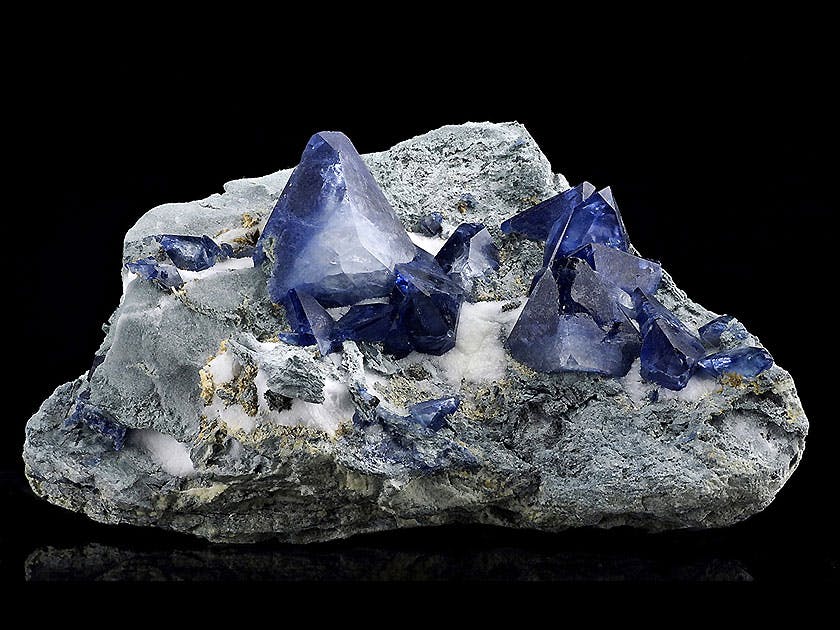
Natural benitoite by Anton Watzl Minerals
Clarity Assessment
Another key aspect of evaluating benitoite is its clarity. The clarity of a gemstone refers to the presence or absence of inclusions or flaws within the stone. Inclusions can interrupt light paths, diminishing the stone’s brilliance and visual appeal, which in turn affects its value. Gemologists assess clarity using magnification and the naked eye to determine the type and extent of inclusions.
Benitoite is classified as Type II in the colored gemstone clarity grade, typically having visible inclusions. Top-quality benitoites, often referred to as ‘eye-clean,’ are highly prized because they lack visible inclusions, enhancing their transparency and overall appeal. Common inclusions in benitoite include pyroxene, amphibole, and fractures, which can impact the stone’s brilliance and value.
Cut and Carat Weight
The gemstone’s value is notably influenced by the cut and carat weight of benitoite. A well-executed cut has the potential to enhance the stone’s inherent brilliance and color. Additionally, a superior polish can maximize its luster. Given benitoite’s rarity, faceting decisions often balance showcasing the gem’s beauty with minimizing waste.
Most benitoite stones are found in smaller sizes, typically less than two carats. Stones larger than five carats are extremely rare. Those exceeding ten carats are considered museum-quality specimens. The value of a benitoite stone increases significantly with size, making larger stones exceedingly valuable and sought after.
6 METAPHYSICAL AND HEALING PROPERTIES
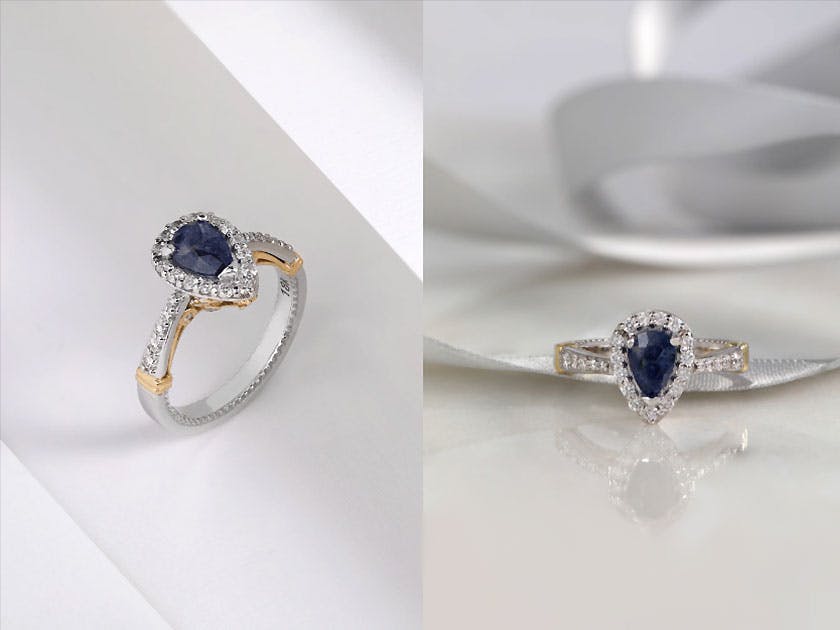
Benitoie Ring by Ayagem
In addition to its physical allure, benitoite also commands reverence for its metaphysical and healing properties. It is believed to promote physical, mental, and spiritual health, offering benefits such as cleansing and purifying the body, boosting energy levels, and encouraging positive thinking. Metaphysically, benitoite is said to assist in astral travel, enhance psychic abilities, and provide protection against negative energies.
Benitoite is also thought to stimulate the third-eye and crown chakras, aiding in intuition, communication, and self-expression. When used in meditation, it can facilitate astral travel, leading to feelings of calmness and centeredness, and encouraging creativity and positive thinking.
Whether you believe in these physical properties or simply appreciate the gemstone’s beauty, benitoite offers a fascinating blend of physical and metaphysical appeal.
7 USES AND BENEFITS OF BENITOITE
More than just an attractive gemstone, benitoite is also reputed to provide several health benefits. Physically, it has been utilized to treat:
-
blood disorders
-
blood circulation issues
-
digestive problems
-
respiratory issues
These purported benefits make benitoite a valuable stone for those seeking holistic health remedies.
Emotionally, benitoite is believed to:
-
Relieve stress, anxiety, and depression, promoting inner peace and calmness
-
Encourage positive thinking and creativity, often used in meditation
-
Help maintain health and happiness when worn or carried as a talisman
However, it is advised to avoid using benitoite for psychotic mental health disorders.
8 CARING FOR BENITOITE STONES
Maintaining the beauty and integrity of benitoite stones necessitates proper care. Here are some tips for cleaning and caring for benitoite:
-
Clean the stones once or twice per month, depending on usage.
-
Use a soft cloth free of dust and fine debris to clean the stones.
-
Avoid using heat, ultrasonic machines, or chemicals, as these can damage the stone.
By following these care instructions, you can keep your benitoite stones looking beautiful for years to come.
Additionally, when wearing benitoite, it is important to:
-
Avoid white gold with rhodium plating, as the re-plating process can damage benitoite.
-
Over time, professional cleaning and polishing may be needed to restore benitoite’s natural luster.
-
To prevent scratches, keep benitoite away from hard, abrasive materials.
Following these guidelines will ensure that your benitoite stones remain as stunning as the day you acquired them.
9 BENITOITE IN COLLECTIONS AND DISPLAYS
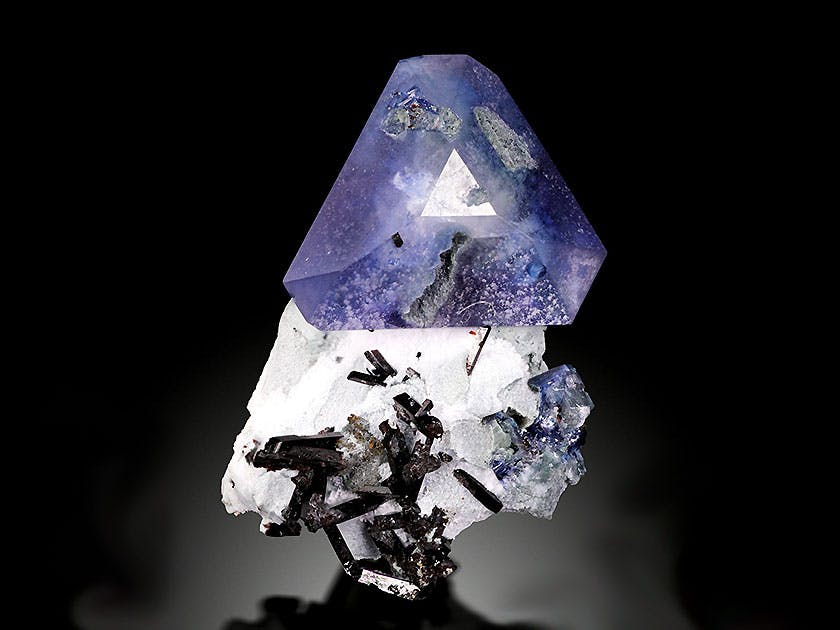
Benitoite with Neptunite by The Arkenstone
Owing to its rarity and unique properties, benitoite is a cherished addition to gem and rare mineral collections. Collectors prize benitoite for its intense blue color and the fascinating geological conditions required for its formation. Its scarcity and beauty make it one of the rarest gems, especially for those who have visited the benitoite mine.
In educational settings, benitoite is often featured in museum exhibits and mineralogical magazine articles to help visitors learn about gemstones and mineralogy. These displays highlight benitoite’s unique geological formation and the specific conditions required for its creation. As a result, benitoite not only captivates collectors but also serves as an educational tool, showcasing the wonders of geological processes.
10 FAMOUS BENITOITE SPECIMENS
A few benitoite specimens have garnered fame due to their exceptional gem quality crystals among the multitude of samples and their associated minerals. The Josie Scripps specimen, measuring 18 cm wide, is well-regarded in the mineral community for its size and beauty. Another notable specimen from the California State Gem Mine, featuring joaquinite, measures 10.6 x 7.5 x 5.3 cm. These specimens represent the new California gem mineral discoveries that continue to captivate collectors and enthusiasts alike.
The ‘Wreath,’ approximately 6 cm wide, is one of the best-known benitoite specimens. Other famous specimens include those with neptunite crystals, such as a 10.1 cm wide piece featuring a 4.3 cm doubly terminated neptunite crystal. These specimens showcase the extraordinary beauty and rarity of benitoite, making them prized pieces in any collection.
11 BUYING AND SELLING BENITOITE
A thorough understanding of the market is crucial when trading benitoite. Prices for benitoite average around $3,000 per carat, with smaller sizes typically costing about $700 per carat. Due to the rarity of larger stones, finding benitoite over one carat can be challenging.
To ensure the authenticity of your purchase, check the seller’s reputation and reviews. While synthetic benitoite is rare in the market, it is still wise to be cautious of fakes. Benitoite gems are often sold on various platforms like eBay and Etsy, so thorough research and verification are essential before making a purchase.
12 SUMMARY
In conclusion, benitoite is a gem that captivates both the eye and the mind. From its unique geological formation in San Benito County to its stunning blue hue and metaphysical properties, benitoite stands out as a rare and valuable gemstone. Whether you are a collector, a gem enthusiast, or someone intrigued by its healing properties, benitoite offers a blend of beauty, rarity, and fascinating history that is truly unparalleled. Let the allure of benitoite inspire you to explore and appreciate this extraordinary gemstone.
